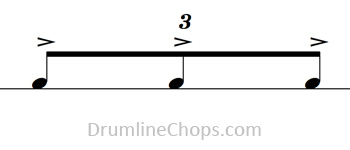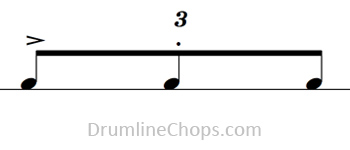
Triple Strokes can be difficult to play because they take a refined ability to control the drum stick while allowing it to rebound naturally.
As a result, a number of drummers struggle to develop their Triple Strokes and often get frustrated whenever they have to play them. If you get frustrated with the way your triple strokes sound, don’t worry. You’re not alone.
Drumline Chops member Ryan P. wrote in and asked, “I’m struggling with my triple stroke rolls. I have trouble getting that third hit in there. Any Tips?”
Jacob M. also wrote in and asked, “I seem to be struggling with the right hand Triple Stroke on Flam Taps. I can do the triple stroke just fine on Flam Accents (the low three note grouping), but I can’t seem to get my right hand to do the triple stroke in Flam Taps. Any suggestions as to how to train my right hand to do the Triple Stroke on Flam Taps?”
Since you’re reading this article, you’re probably asking the same or similar questions as Ryan and Jacob. Lucky for you, we’re going to address those questions and help you solve your Triple Stroke problems once and for all!
A lot of people think that there is only one way to play a triple stroke. Beyond that, it’s just a matter of technique and chops to work them up and play them well.
However, there are actually two approaches to playing triple strokes and each approach has its own place purpose. Furthermore, using the right approach at the right time can have an immediate impact on your playing.
As you continue on with this article, you’ll learn why choosing the appropriate approach is crucial, but let’s quickly go over the difference between the two.
Triple Stroke Approach 1: Single Stroke The first approach to Triple Strokes is to play every single note of the triple stroke with individual wrist turns to create a grouping of three individual notes of the same velocity and volume.

In the written example above, you’ll notice that every single note has an accent on it to represent the fact that every note of the triple stroke grouping is played as an individual stroke creating three notes of identical volume. Essentially, you are just creating three single strokes and grouping them together at a Triple Stroke.
In all honesty this isn't a true Triple Stroke, but there are times where you need to treat a written triple stroke in this manner and it is also an approach that a lot of rudimental drummers take to play their triple strokes so it makes sense to address it.
Triple Stroke Approach 2: Rebounded The second approach to Triple Strokes is to create three notes from one stroke. In other words, you make one primary wrist turn to create the first note and then utilize the natural rebound of the stick to create the second and third notes.

In the written example of the second approach, you’ll see the first note has an accent on it to represent the primary stroke, the second note has a staccato marking to represent a “half accent,” and the third note is unmarked to represent the lowest note of the grouping.
As mentioned above, a lot of rudimental drummers struggle with Triple Strokes because they pick one of the approaches and use it for all Triple Stroke purposes.
But here’s the problem with that - neither of them work for every Triple Stroke situation.
You need to work both of them up so that you have both of them in your toolbox ready to go when you need them. Generally speaking, the rebounded approach is more accurate and versatile so it should be the primary approach you use in Triple Stroke situations. However, a lot of drummers just don’t spend the time working up the ability to create three notes out of one stroke and therefore resort to using the single stroke approach 100% of the time.
That's bad news bears!
The single stroke approach is really good for slower tempo triple strokes and for moments when the music specifically calls for every note of the triple stroke to be the same volume. The rebounded approach is ideal for most all other types of triple stroke situations including faster tempo triple strokes and accented triple strokes.
One thing to take note of is the fact that a lot of Triple Stroke situations are intended to have a natural flow to them. If you’re stroking out every single note as you do in the first approach, it’s easy to get bogged down and hinder the flow. By utilizing the rebounded approach in those situations, you’re much more likely to produce your desired sound throughout the passage.
Why? Think of it this way...
When you play double strokes at slow tempos, you play each note with an individual stroke at the same volume.
However, if you were to continue to use this approach as the tempo increased you would begin to struggle and severely limit your maximum roll tempo simply because your muscles and tendons wouldn’t be able to keep up.
Instead, as the speed of your double strokes increase, you naturally shift to using diddles and you create two notes out of one stroke. The audible volume difference between the two notes is very minimal and it allows you to play your rolls much much faster with less energy and more control.
The same concept is true for Triple Strokes.
You can utilize the single stroke approach at slow tempos but as the speed increases you need to shift to the rebounded approach so that you’re getting three notes out of one stroke. Now that you know why each approach is important to develop and what they're strengths are, let's talk about how you can improve the quality of your Triple Strokes.
Below are two easy and effective exercises that will improve your triple strokes.
The first exercise is a simple Triple Stroke exercise that works on keeping an 8th note base consistent so that your hand to hand transitions from one Triple Stroke to the next sound smooth. It’s simply a measure of eighth notes with alternating sticking followed by a measure of Triple Strokes.

The second exercise is the Gallop Double Stroke exercise, but instead of playing it with double strokes, you play it with triple strokes. This one is great because it isolates your individual hands and then gradually starts combining them over time. Insiders can watch the Gallop Triple Stroke lesson here.
Be sure to practice both of these triple stroke exercises at various tempos so that you can practice both approaches of triple strokes. Once you start to become comfortable with each one, you’ll notice that your Triple Strokes will become better and your ability to play any rudiment with triple strokes will also improve.
Triple Strokes can be difficult because they require a refined balance of relaxation and control. There are two approaches to playing triple strokes and each method has its own place and purpose. In order to improve your triple strokes, it’s important that you practice and master each approach individually. Then, whenever you have a triple stroke in a musical setting, be sure to determine which of the two approaches you should be using and apply it.



Pat McLaughlin is the founder of Drumline Chops. He graduated from the University of North Texas with a degree in music education and is currently the percussion director at West Bloomfield High School.